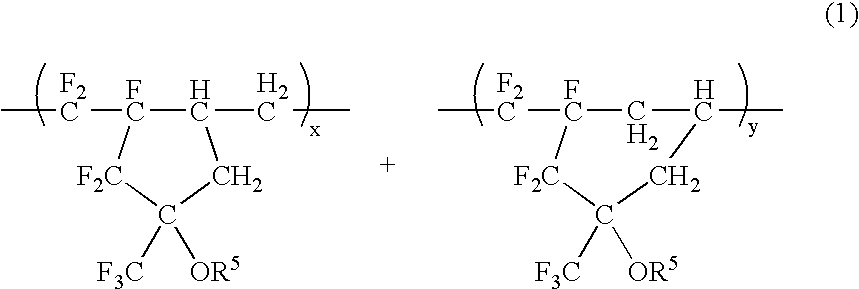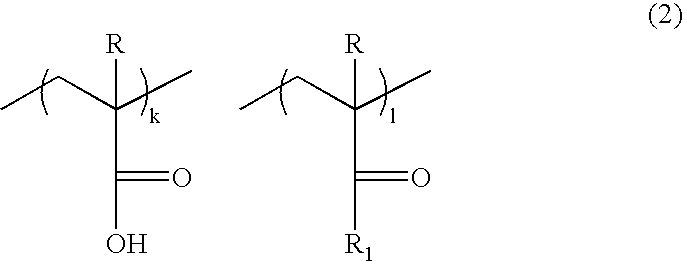Solvent For Cleaning Semiconductor Manufacturing Apparatus
a technology for cleaning solvents and semiconductor manufacturing equipment, applied in the preparation of detergent mixture compositions, organic chemistry, detergent compositions, etc., can solve the problems of insufficient transparency of topcoat protective films, reduced focal depth widths, and shortening of optical wavelengths, so as to improve cleaning capability and reduce the amount of cleaning solvents. , the effect of high transparency
- Summary
- Abstract
- Description
- Claims
- Application Information
AI Technical Summary
Benefits of technology
Problems solved by technology
Method used
Image
Examples
examples
[0034]The present invention is explained in detail with reference to the below Examples. The present invention should not be construed in any way as to be limited to the below Examples.
[0035]Using isobutyl alcohol (IBA) as the cleaning solvent of the present invention, the reduction of particles from the cleaning solvent through filtration by various filter materials made of polyethylene (PE), polypropylene (PP) and nylon was investigated.
examples 1 to 4
[0036]The filter materials having the various pore sizes (in parenthesis) shown in Table 1 below were used as the various filter materials. More specifically, by filtering IBA through filters made of PE (0.05 μm, Example 1), PP (0.05 μm, Example 2), nylon (0.04 μm, Example 3), and PP (0.02 μm, Example 4), respectively, cleaning solvents were obtained.
[0037]The particles in these cleaning solvents were measured using a particle counter. The results are shown in Table 1.
TABLE 1Measurement Result of Particle CounterPoreSol-FilterSizeSize of Particles (μm)ventMaterial(μm)≧0.135≧0.15≧0.2≧0.22≧0.3Ex. 1IBAPE0.0511.48.13.01.90.6Ex. 2IBAPP0.057.73.31.20.80.1Ex. 3IBANylon0.049.26.72.92.21.0Ex. 4IBAPP0.025.22.81.00.80.4unit: particle number / ml
[0038]The results of Table 1 demonstrate that particles contained in IBA are greatly reduced by use of the various filter materials described above.
example 5
[0039]Formation of a topcoat protective film was investigated in relation to a resist film to which the cleaning solvent according to the present invention had been applied.
[0040]The resin component, the acid generator, and the nitrogen-containing organic compound described below, were dissolved homogeneously into an organic solvent to prepare a resist composition.
[0041]The copolymer consisting of the constitutional units, expressed by the chemical formula (4) shown below, was used in an amount of 100 parts by mass as the resin component. The ratio of constitutional units l, m, and n for preparing the resin component was that l is 20 mole %, m is 40 mole %, and n is 40 mole %.
[0042]2.0 parts by mass of triphenylsulfonium nonafluorobutanesulfonate and 0.8 parts by mass of tri(tert-butylphenyl)sulfonium trifluoromethane sulfonate were used as the acid generator.
[0043]In addition, an aqueous solution with a 7.0% concentration of a mixed solvent of propyleneglycol monomethylether and pr...
PUM
| Property | Measurement | Unit |
|---|---|---|
| boiling point | aaaaa | aaaaa |
| pore size | aaaaa | aaaaa |
| width | aaaaa | aaaaa |
Abstract
Description
Claims
Application Information
 Login to View More
Login to View More - R&D
- Intellectual Property
- Life Sciences
- Materials
- Tech Scout
- Unparalleled Data Quality
- Higher Quality Content
- 60% Fewer Hallucinations
Browse by: Latest US Patents, China's latest patents, Technical Efficacy Thesaurus, Application Domain, Technology Topic, Popular Technical Reports.
© 2025 PatSnap. All rights reserved.Legal|Privacy policy|Modern Slavery Act Transparency Statement|Sitemap|About US| Contact US: help@patsnap.com



